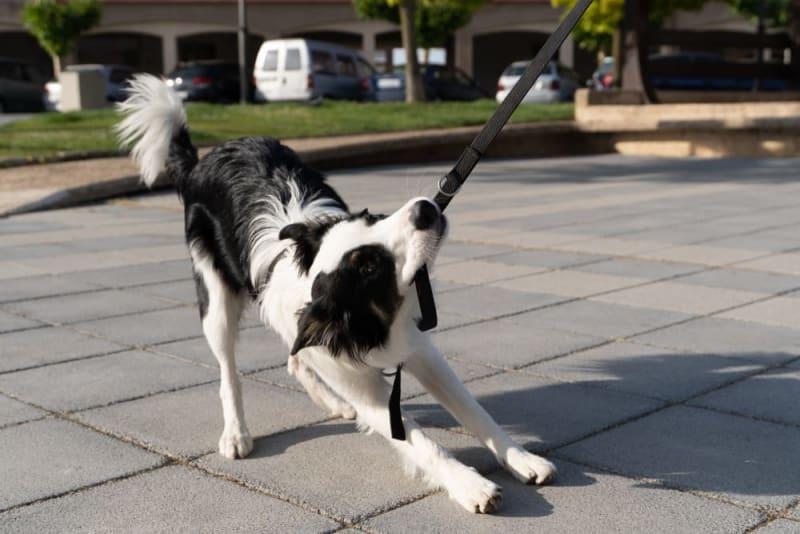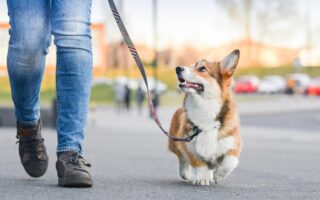Unraveling Leash Aggression: Understanding the Dark Side of Dog Walking
Walking your dog should be a peaceful and enjoyable experience, a moment to connect with nature and bond with your furry companion. Yet, for many pet owners, a daily stroll can transform into a perilous tug-of-war, fraught with tension and anxiety. Enter the phenomenon of leash aggression—a behavior that leaves countless dogs reacting vehemently to the perceived threat of another canine as they navigate sidewalks, parks, and neighborhoods. But what lies beneath this instinctive response? In this article, we will explore the origins and manifestations of leash aggression, shedding light on the psychological factors at play and offering insights to help dog owners foster a calmer, more harmonious walking experience. Whether you’re grappling with a furiously barking pup or simply curious about canine behavior, join us as we venture into this complex issue and uncover strategies for managing leash aggression effectively.
Table of Contents
- Understanding the Roots of Leash Aggression in Dogs
- Recognizing the Warning Signs and Triggers of Leash Aggression
- Effective Strategies for Managing and Reducing Leash Aggression
- Building a Positive Leash-Walking Experience for You and Your Dog
- Q&A
- The Way Forward
Understanding the Roots of Leash Aggression in Dogs
Leash aggression in dogs often stems from a complex mix of fear, frustration, and territorial instincts. When dogs are restrained by a leash, their natural fight-or-flight response can be heightened, leading them to perceive other dogs or unfamiliar people as threats. This reaction becomes compounded by their inability to approach or retreat, manifesting as vocalizations or aggressive behavior. Recognizing the signs of leash aggression early is essential for effective management and training, which may include:
- Reactive barking
- Snapping or lunging
- Stiff body posture
- Tail position changes
Additionally, prior experiences play a significant role in shaping a dog’s perception of the world during walks. A negative encounter, such as an aggressive dog approaching while on a leash, can quickly lead to conditioned responses where the dog associates leashes with stress and confrontation. To address this behavior effectively, positive reinforcement training methods are often recommended. This can include:
| Training Technique | Description |
|---|---|
| Desensitization | Gradually exposing the dog to triggers at a distance, rewarding calm behavior. |
| Counter-conditioning | Changing the dog’s emotional response to stimuli by pairing exposure with treats. |
| Focus and engagement | Teaching the dog to focus on the handler instead of distractions. |
Recognizing the Warning Signs and Triggers of Leash Aggression
Understanding the signs that indicate a dog is prone to leash aggression can be crucial in fostering a harmonious environment for both pets and their owners. Recognizing these indicators early can make a significant difference in how you manage your dog’s behavior on walks. Look for the following warning signs:
- Pacing or pulling: If your dog is constantly tugging on the leash, they may be on high alert.
- Loud vocalizations: Growling, barking, or whining can signal distress or aggression.
- Body posture: A rigid stance and raised hackles are clear indicators of a dog that feels threatened.
- Staring intently: If your dog fixes their gaze on another animal or person, it could mean they are preparing to react.
Furthermore, it’s essential to identify specific triggers that provoke such aggressive tendencies. These could vary from one dog to another, and pinpointing them is key to effective management. Consider the following common triggers:
- Other dogs: Encountering unfamiliar dogs during walks can lead to unease.
- People: Strangers or specific individuals approaching can increase anxiety.
- New environments: Unfamiliar settings may overwhelm your dog and heighten aggression.
- Noise: Loud sounds may startle your dog, eliciting a defensive reaction.
Effective Strategies for Managing and Reducing Leash Aggression
Managing leash aggression requires a combination of patience, consistency, and understanding your dog’s behavior. One effective strategy is to practice positive reinforcement. Whenever your dog remains calm in the presence of another dog or person, reward them with treats or praise. This approach helps to reinforce the desired behavior, making it more likely that your pet will react calmly in future situations. Desensitization is another critical technique. Gradually expose your dog to stimuli that cause aggression from a distance, rewarding them for calmness, and gradually decreasing the distance as they become more comfortable.
Building a solid foundation of obedience training is essential for dogs prone to leash aggression. Consider focusing on commands such as “sit,” “stay,” and “leave it.” This training not only enhances communication between you and your dog but also provides a means to redirect their attention during challenging situations. Additionally, utilizing specialized tools like no-pull harnesses can aid in managing physical pulling while providing extra control. Pairing these strategies will create a more controlled environment, significantly reducing the likelihood of aggressive outbursts on the leash.
Building a Positive Leash-Walking Experience for You and Your Dog
Leash aggression often stems from a dog’s instinct to protect itself or assert dominance when faced with social situations. Understanding the reasons behind this behavior is crucial for creating a harmonious experience on walks. It’s important to recognize that your dog might be reacting to specific triggers, including other dogs, fast-moving pedestrians, or loud noises. By identifying these triggers, you can gradually work on desensitizing your dog in a safe and controlled manner, ensuring that walks become a source of joy rather than stress.
To cultivate a positive atmosphere while walking your dog, consider implementing the following strategies:
- Use positive reinforcement: Reward your dog with treats and praise for calm behavior when encountering potential triggers.
- Practice distance: Begin with a comfortable distance from other dogs or distractions to help your dog stay relaxed.
- Incorporate training sessions: Teach commands such as “leave it” or ”look at me” to redirect your dog’s attention during challenging moments.
- Maintain a steady pace: Avoid sudden movements or changes in direction that may startle your dog and escalate anxiety.
| Training Technique | Benefit |
|---|---|
| Desensitization | Reduces anxiety over time by gradual exposure. |
| Counter-conditioning | Helps in changing the perception of triggers from negative to positive. |
| Structured walks | Encourages focus and improves communication between dog and owner. |
Q&A
Q&A: Understanding Leash Aggression in Dogs
Q1: What exactly is leash aggression?
A1: Leash aggression refers to a behavioral issue where a dog becomes overly excited, aggressive, or anxious when it is on a leash and encounters other dogs, people, or animals. This reaction can manifest as barking, lunging, growling, or even snapping. It’s not uncommon for an otherwise friendly or well-socialized dog to develop leash aggression due to the constraints of being on a leash, which can create a sense of frustration or anxiety.
Q2: What causes leash aggression?
A2: Leash aggression can stem from several factors. Some dogs may feel restricted by the leash, which can trigger a fight-or-flight response. Others may perceive other dogs or strangers as threats and react defensively. Past negative experiences, lack of socialization, or a dog’s inherent personality traits can also contribute to this behavior. Essentially, leash aggression often arises from a combination of environmental triggers, emotional responses, and learned behaviors.
Q3: Are certain breeds more prone to leash aggression?
A3: While leash aggression can affect dogs of any breed, size, or temperament, some breeds are more prone to the behaviors associated with it, particularly those known for their protective or territorial instincts. However, it’s essential to remember that leash aggression is influenced more by individual personality and past experiences than by breed alone. Proper training and socialization can help mitigate these tendencies in any dog!
Q4: How can I identify if my dog is experiencing leash aggression?
A4: Signs of leash aggression can vary from subtle to overt. Common indicators include stiff body posture, growling, barking, lunging towards or away from the perceived threat, and excessive whining. A dog may also fixate on the target, pulling hard on the leash. If your dog displays these behaviors consistently when approached by other dogs or people, it may be experiencing leash aggression.
Q5: What can I do to manage leash aggression in my dog?
A5: Addressing leash aggression requires a combination of patience, training, and desensitization techniques. Here are some strategies:
- Use positive reinforcement: Reward calm behavior with treats and praise to encourage desirable actions.
- Desensitization: Gradually expose your dog to potential triggers from a distance where they feel secure. Slowly decrease the distance as they become more comfortable.
- Redirect focus: Carry treats or a favorite toy to distract your dog when encountering triggers, shifting their focus to something positive.
- Walk with confidence: Your demeanor matters! A relaxed, confident handler can help calm an anxious dog.
- Seek professional help: If the behavior persists, consulting a professional dog trainer or behaviorist may be beneficial. They can provide tailored guidance based on your dog’s specific needs.
Q6: Can leash aggression be completely resolved?
A6: While some dogs may largely overcome leash aggression through consistent training and exposure, others may always exhibit certain behaviors on a leash. The goal is often to manage and minimize the reactions rather than eliminate them entirely. With time, practice, and positive experiences, many dogs can learn to walk calmly on a leash, making outings more enjoyable for both the dog and the owner. Remember, patience is key!
Q7: How can I prevent leash aggression in a puppy?
A7: Prevention is best accomplished through early socialization. Expose your puppy to various environments, people, and other animals in a controlled manner. Engaging in positive experiences will help build their confidence. Basic obedience training can also create a strong bond and establish good behaviors right from the start. The foundation you lay during this crucial developmental stage can significantly reduce the likelihood of leash aggression in adulthood.
Q8: Is it ever safe to let a dog displaying leash aggression off-leash?
A8: It’s typically not advisable to allow a dog exhibiting leash aggression to roam freely off-leash until the behavior is properly managed or mitigated. Uncontrolled environments can lead to unpredictable encounters that may exacerbate the aggression or lead to fights. Always prioritize safety — for your dog, yourself, and others — and work on resolving leash aggression before considering off-leash fun.
—
Understanding leash aggression is the first step toward a happier dog and a more pleasant experience on walks. With dedication and the right approach, you can guide your furry friend toward calmer and more controlled outings. Happy walking!
The Way Forward
In navigating the complexities of leash aggression, it’s essential for dog owners to approach the issue with patience, understanding, and a willingness to learn. As we’ve explored, this behavior doesn’t arise in a vacuum; it is often a manifestation of fear, anxiety, or territorial instincts. By fostering an environment that emphasizes positive reinforcement, socialization, and consistent training, we can help our furry companions overcome their challenges and thrive in their interactions with the world around them.
Ultimately, addressing leash aggression is not just about correcting undesirable behavior but about nurturing a deeper bond between you and your dog. With time, dedication, and the right strategies, your walks can transform from stressful experiences into enjoyable adventures—where both you and your dog can explore the world side by side, confidently and happily. So, let us embark on this journey of understanding and growth together, ensuring that every outing becomes a testament to the strength of your partnership. Happy walking!



